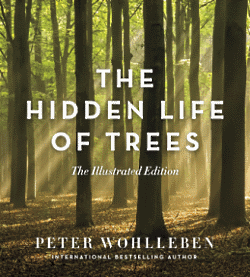
Peter Wohlleben, Author,
Jane Billinghurst, Translator
Greystone Books Ltd.
Courtesy Greystone Books Ltd.
Today, I will describe something that has opened my eyes to a world that few people know about. I refer to the research revealed in a book titled “The Hidden Life of Trees”, an International Bestseller, by Peter Wohlleben. He is a Forester-Scientist in Germany who has connected with others in his profession for over 20 years to reveal things about trees that most of us would never have expected. Here is Part One:
You may recall the basic photosynthesis functions related to the lives of trees. Roots carry water and minerals from the soil through the xylem tissues of the trunk up to the leaves. The leaves, with the help of chlorophyll, capture Sunlight Energy and Carbon Dioxide from the atmosphere, and release Oxygen into the air. Sugars are also produced and go downward through the phloem tissues to the trunk and roots. The way I remembered this process in biology classes was that the X in xylem has its upper lines reaching skyward, and things Flow downhill.
The scientists knew that most individual trees of the same species growing in the same forest stand are connected to each other through their root systems. Nutrient exchanges revealed that forests are superorganisms with interconnections much like ant colonies. This indicated a sort of social system where trees will share food with their own species and sometimes even nourish their competitors. Why are they considered social beings? Because there are advantages in working together.
It seems that single trees, much like hermits, have greater difficulties in having a successful life. It can be done, but it’s tough. A single tree cannot establish a consistent local climate and must battle weather conditions. Whereas a forest often creates an ecosystem that can somewhat modify extreme temperatures, store a lot of water, and generate a lot of humidity. These kind of living conditions can provide trees with great longevity. But for this success the forest must remain intact. Tree removal, or fatalities, would result in gaps in the tree canopy, which would then allow for greater deviations in temperatures, make trees more vulnerable to uprooting from storms, and allow greater summer heat to dry out the forest floor. Every tree would then suffer.
Wohlleben continues to say that social connections can also be seen in the forest canopy. Most trees grow their branches out until they encounter the branch tips of a neighboring tree of the same height. Growth usually stops there because the air and better light in that space is already being used, and the trees don’t want to take anything away from each other.
But, as a rule, those planted in forests can live much like single wild trees and react by suffering from isolation. And remember that he is writing about forests, not single trees planted in a well-kept yard or for landscaping.
I’ll continue referencing “The Hidden Life of Trees” in future shows and talk about Why Forests are Green; How they act as a Water Pump, and are Carbon Dioxide Vacuums.
This is Ron Hellstern, and I am Wild About Utah.
Credits:
Images: Courtesy & Copyright Greystone Books, LTD,
Lead Audio: Courtesy and Copyright
Text: Ron Hellstern, Cache Valley Wildlife Association
Additional Reading
Wohlleben, Peter, The Hidden Life of Trees, Jane Billinghurst, Translator, Greystone Books Ltd., 2016, https://www.amazon.com/Hidden-Life-Trees-Illustrated/dp/177164348X
Wohlleben, Peter, The Hidden Life of Trees – The Illustrated Edition, Jane Billinghurst, Translator, Greystone Books Ltd. 2018, https://www.amazon.com/Hidden-Life-Trees-Illustrated/dp/177164348X
Noe, Alva, A Web Of Trees And Their ‘Hidden’ Lives, National Public Radio, September 23, 2016, https://www.npr.org/sections/13.7/2016/09/23/494989594/a-web-of-trees-and-their-hidden-lives
Kuhns, Michael, https://upcolorado.com/utah-state-university-press/item/2130-a-guide-to-the-trees-of-utah-and-the-intermountain-west
Little, Elbert L, National Audubon Society Field Guide to North American Trees–W: Western Region, Chanticleer Press https://www.amazon.com/National-Audubon-Society-American-Trees-W/dp/0394507614 alternatively https://www.penguinrandomhouse.com/books/119974/national-audubon-society-field-guide-to-north-american-trees–w-by-national-audubon-society/
Watts, Tom & Bridget, Rocky Mountain Tree Finder, Nature Study Guild, Menasha Ridge Press, Birmingham, AL https://www.amazon.com/Rocky-Mountain-Tree-Finder-Watts/dp/0912550295 alternatively
https://www.menasharidge.com/product.php?productid=17125
What Tree Is That, A Guide to More Common Trees Found in North America, The Arbor Day Foundation, Nebraska City, NE, https://www.amazon.com/What-Tree-That-America-Recipient/dp/0963465759 alternatively https://www.arborday.org/trees/whattree/whatTree.cfm?ItemID=E6A
Tree Identification Index, USU Extension Forestry, https://forestry.usu.edu/tree-identification/index
Kuhns, Michael, Rupp, Lawrence, Selecting and Planting Landscape Trees, USU Extension Forestry, https://forestry.usu.edu/files/selecting-and-planting-landscape-trees.pdf
Key To The Trees Of Logan Canyon, USU Extension Forestry, https://forestry.usu.edu/tree-identification/keys-to-trees-of-logan/keys-to-trees-of-logan-canyon
